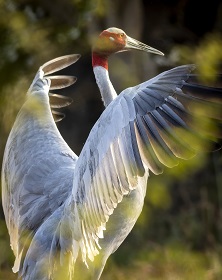Jan 08, 2026
Jan 08, 2026
Conservation Efforts for Indian Wildlife



In the vast and diverse landscapes of India, the remarkable wildlife that inhabits its forests, grasslands, and wetlands is a source of national pride and global admiration. The rich biodiversity of this country plays a crucial role in maintaining ecological balance and contributing to the world's natural heritage. However, rapid urbanization, habitat loss, and human activities have posed significant threats to India's unique fauna and flora. To safeguard these treasures for future generations, a multitude of dedicated organizations, government initiatives, and passionate individuals have risen as guardians of the wilderness. This article delves into the profound conservation efforts aimed at protecting Indian wildlife.
Introduction: The Importance of Indian Wildlife
India's natural landscapes host an astounding variety of species, from the majestic Bengal tiger to the charismatic Indian elephant and the vibrant bird species that fill the skies. The interconnectedness of these species with their habitats makes for a delicate balance that sustains life as we know it. The cultural significance of wildlife is deeply ingrained in Indian society, with animals often revered as symbols of strength and spirituality.
Threats to Biodiversity: Understanding the Challenges
Despite the intrinsic value of wildlife, numerous threats loom large. Habitat destruction due to urban expansion and industrialization disrupts ecosystems, pushing species to the brink of extinction. Poaching for the illegal wildlife trade further exacerbates the crisis, with animal parts sought after for traditional medicine and luxury goods. Climate change adds another layer of complexity, altering habitats and migration patterns.
National Parks and Wildlife Sanctuaries: Havens for Protection
Recognizing the urgent need to safeguard ecosystems, India has established an extensive network of national parks and wildlife sanctuaries. These protected areas offer safe havens for various species to thrive without the threat of human interference. Iconic parks like Jim Corbett and Kaziranga have become sanctuaries for iconic species like tigers and rhinos.
Project Tiger: Preserving the Majesty of the Bengal Tiger
Project Tiger stands as one of India's most successful conservation initiatives. Launched in 1973, it focuses on protecting the Bengal tiger and its habitats. By establishing tiger reserves and implementing stringent anti-poaching measures, Project Tiger has played a pivotal role in stabilizing the tiger population and raising awareness about their critical role in the ecosystem.
Project Elephant: Ensuring the Well-being of Gentle Giants
With its diverse landscapes, India is also home to a significant population of elephants. Project Elephant, initiated in 1992, concentrates on safeguarding these intelligent creatures. Human-elephant conflict mitigation, habitat restoration, and scientific research are key components of this project.
Save Our Sparrows: Battling the Decline of Common Birds
While large mammals often steal the spotlight, even common species like sparrows face alarming declines. The Save Our Sparrows campaign illustrates how community-led efforts and public awareness can make a difference in conserving even the smallest members of the animal kingdom.
Marine Conservation: Protecting India's Coastal and Marine Life
India's vast coastline is home to diverse marine life, including coral reefs, dolphins, and various fish species. Marine conservation efforts encompass sustainable fishing practices, protection of critical habitats, and awareness campaigns to combat plastic pollution.
Community Involvement: Empowering Locals as Guardians
Empowering local communities as stewards of wildlife is integral to successful conservation. Collaborative efforts involve training and employment opportunities that provide alternatives to activities harmful to wildlife, fostering a sense of ownership and responsibility.
Conservation through Education: Raising Awareness for a Cause
Raising awareness about the importance of wildlife conservation begins with education. Schools, NGOs, and governmental organizations conduct workshops and awareness campaigns to instill a sense of responsibility and care for nature from an early age.
Technological Innovations: Using Science for Wildlife Protection
Modern technology offers innovative solutions for wildlife protection. From camera traps to monitor elusive species to drones for anti-poaching surveillance, these tools enhance the efficiency of conservation efforts.
Legal Framework: Wildlife Protection Laws and Regulations
India boasts a comprehensive legal framework for wildlife protection, including the Wildlife Protection Act. These laws serve as the backbone of conservation efforts, enabling authorities to combat poaching, habitat destruction, and illegal trade effectively.
Success Stories: Celebrating Remarkable Conservation Achievements
Several inspiring success stories exemplify the effectiveness of conservation efforts. The revival of the hangul deer population in Kashmir and the successful relocation of villages from critical tiger habitats stand as a testament to the commitment of various stakeholders.
Challenges Ahead: Continuing the Fight for Wildlife Conservation
Despite significant achievements, the journey ahead is fraught with challenges. Rapid urbanization, climate change, and the ever-present threat of poaching demand persistent efforts and innovation to ensure the survival of India's unique wildlife.
International Collaborations: Sharing Expertise for Global Impact
Wildlife conservation knows no borders, and India actively collaborates with international organizations to share knowledge, expertise, and best practices. Such collaborations amplify the impact of conservation efforts on a global scale.
Conclusion: A Collective Responsibility to Protect and Conserve
Guardians of the wilderness in India come in various forms – from governmental bodies to local communities and individuals driven by passion. The conservation narrative underscores the collective responsibility of safeguarding the country's precious biodiversity for future generations to cherish and learn from.
FAQs
Why is Indian wildlife important?
Indian wildlife is crucial for maintaining ecological balance, cultural significance, and contributing to global biodiversity.
What are the major threats to Indian wildlife?
Habitat loss, poaching, climate change, and human-wildlife conflict are among the significant threats.
How does Project Tiger contribute to conservation?
Project Tiger focuses on protecting the Bengal tiger and its habitats through reserves and anti-poaching efforts.
What is the significance of community involvement in conservation?
Involving local communities creates a sense of responsibility and helps in sustainable wildlife protection.
How can individuals contribute to wildlife conservation?
Individuals can support conservation by raising awareness, supporting NGOs, and making environmentally conscious choices.
Images (c) istock.com
19-Aug-2023
More by : Suren Rathore